Arm's Cortex-A76 CPU Unveiled: Taking Aim at the Top for 7nm
by Andrei Frumusanu on May 31, 2018 3:01 PM EST- Posted in
- CPUs
- Arm
- Smartphones
- Mobile
- SoCs
- Cortex-A76
Performance & Power Projections
Now that we’ve had more insight into the A76’s microarchitecture – there’s always a disconnect between theoretical performance based on overlying µarch and how it ends up in practice. We’re first going to look at ISO-process and ISO-frequency comparisons which means the generational performance improvements between the cores with otherwise identical factors such as memory subsystems.
In terms of general IPC Arm promises a ~25% increase in integer workloads and a ~35% increase in ASIMD/floating point workloads. Together with up to 90% higher memory bandwidth figures compared to the A75 the A76 is then meant to provide around a 28% increase in GeekBench4 and 35% more JavaScript performance (Octane, JetStream). In AI inferencing workloads the doubled ASIMD 128-bit capabilities of the A76 serves to quadruple the general matrix multiply performance in half precision formats.
These performance figures are respectable but not quite earth-shattering considering the tone of the improvements of the µarch. However it’s to note that we’re expecting the A76 to come first be deployed in flagship SoCs on TSMC’s 7nm process which allows for increased clocks.
Here Arm’s projections is that we’ll be seeing the A76 clocked at up to 3GHz on 7nm, which in turn will result in higher improvements. Quoted figures are 1.9x in integer and 2.5x in floating point subscores of GeekBench4 while we should be expecting total score increases of 35%.
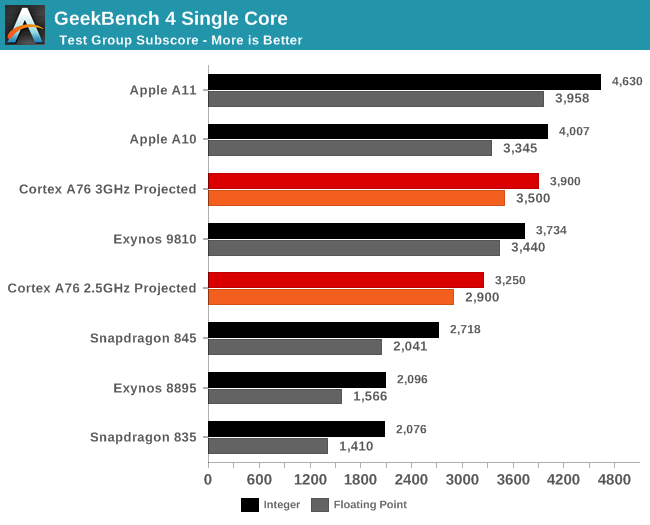
What this means in terms of absolute numbers is projected in the above graph. Baselining on the performance of the Snapdragon 835 and Snapdragon 845 a future SoC with an A76, 512KB L2’s and 2MB L3 would fall in around the GeekBench4 performance of the Exynos 9810 depending if the target 3GHz is reached.
In the past Arm has been overly optimistic when releasing frequency targets – for example the A73 was first projected at up to 2.8GHz and the Cortex A75 projected at up to 3GHz. In the end both ended up at no higher than 2.45GHz and 2.8GHz.
I’ve talked to a vendor about this and it seems Arm doesn’t take into consideration all corners when doing timing signoff, and in particular vendors have to take into consideration process variations which result in differently binned units, some of which might not reach the target frequencies. As mobile chips generally aren’t performance binned but rather power binned, vendors need to lower the target clock to get sufficient volume for commercialisation which results in slightly reduced clocks compared to what Arm usually talks about.
For the first A76 implementations in mobile devices I’m adamant that we won’t be seeing 3GHz SKUs but rather frequencies around 2.5GHz. Arm is still confident that we’ll see 3GHz SoCs but I’m going to be rather on the conservative side and be talking about 2.5GHz and 3GHz projections alongside each other, with the latter more of a projection of future higher TDP platforms.
Arm also had a slide demonstrating absolute peak performance at frequencies of 3.3GHz. The important thing to note here was that this scenario exceeded 5W and the performance would be reduced to get under that TDP target. It wasn’t clear if this was SoC power or solely CPU power – I’ll follow up with a clarification after I reach out to Arm.
Obviously the most important metric here alongside the performance improvements is the power and efficiency targets. In target products comparing Cortex A75 on a 10nm process versus a Cortex A76 on a 7nm process under the same 750mW/core power budget, the Cortex A76 delivers 40% more performance.
In terms of energy efficiency, a 7nm A76 at a performance target of 20 SPECint2006 of an A75 on 10nm (meaning maximum performance at 2.8GHz) is said to use half the amount of energy.
What is important in all these metrics again is that we weren’t presented an ISO-process comparison or a comparison at maximum performance of the A76 at 3GHz, so we’re left with quite a bit of guesswork in terms of projecting the end energy efficiency difference in products. TSMC promises a 40% drop in power versus 10FF. We haven’t seen an A75 implemented on a TSMC process to date so the best baseline we have is Qualcomm’s Snapdragon 845 on Samsung 10LPP which should slightly outperform 10FF.
Going through my projected data on one side we have performance on the right side: I baselined the SPECspeed scores on the average of the Snapdragon 835 and Kirin 970 measured results and applied Arm’s projected IPC claims and scaled the scores for frequency. For the 3GHz A76 projection this gets us the near 2x performance improvements in SPECint2006 vs the A73 generation of cores.
In terms of power efficiency, there’s more guesswork as the only real figure we have is as earlier stated the process scaled efficiency figures. Arm quoted a performance target of 20 SPECint2006 which I suspect is a 2.8GHz A75 run with GCC compiled benchmark binaries which have an advantage over my LLVM figures. If Arm wanted to compare against the Snapdragon 845 this matches roughly a 2.4GHz A76. Accounting for the process power improvement this roughly leaves a ~15% microarchitectural advantage for the A76. However as the A76 is targeted to perform 35% higher, and as we’ve seen in the past performance increases through clock don’t scale linearly with power, the power and efficiency advantages would very quickly degrade at peak performance.
Taking all factor into account as best as I could, we should be seeing 7nm A76 based SoCs beat slightly beat the energy efficiency of current Arm SoCs in terms of absolute energy usage at peak performance, a metric which is important as it is directly proportional to a device’s battery life. At a more conservative 2.5GHz clock this energy efficiency advantage would be greater and around 30% less energy than current generation A73 and A75 SoCs.
So on one hand the A76 would be extremely energy efficient, but also it could very well be a thermally constrained design as its peak performance we’d be seeing quite higher TDP figures. Arm states that the A76 is meant to run at full frequency in quad-core mode, however that claim is limited to larger form-factors, as for mobile devices, based on what I’m hearing vendors, will need to tone it down to lower clocks in order to fit smartphone designs.
Again the projection here contain a lot of variables and I’m erring towards the more conservative side in terms of performance and efficiency- however it’s clear that the jump will be significant in whichever way vendors will decide to push the A76 in (Performance or efficiency).


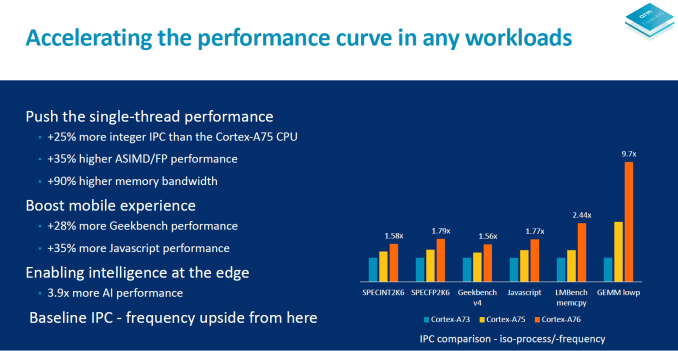

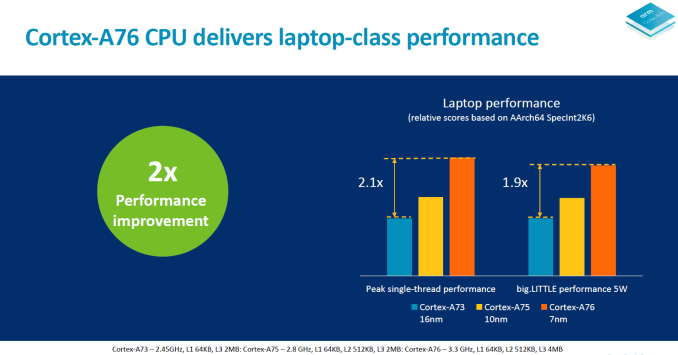
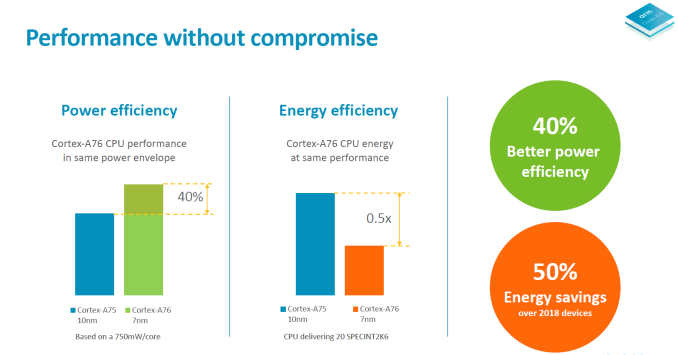
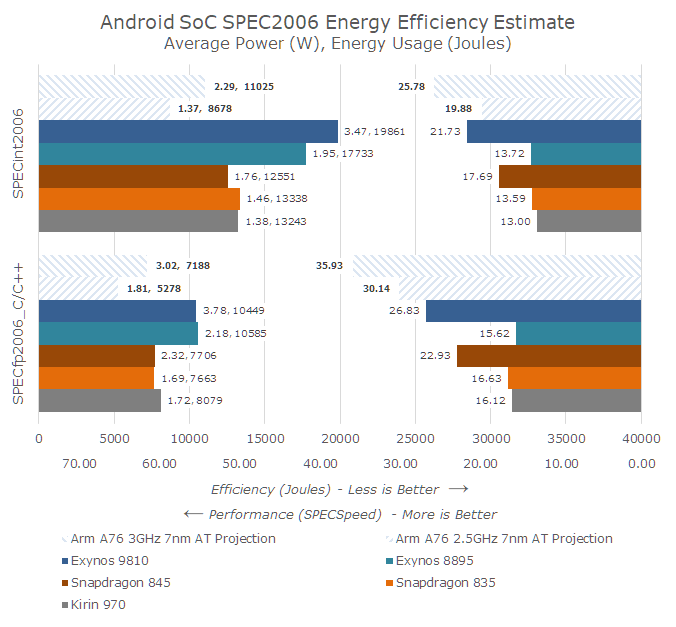














123 Comments
View All Comments
lmcd - Friday, June 1, 2018 - link
They're at the mercy of chipmakers. The only companies that would buy such a core have already left reference designs behind. Everyone else wants small, cheap chips, so much so that we've had A53-only designs in the entire middle-and-lower range. Will anyone even use the A76? I don't know if that's guaranteed.vladx - Friday, June 1, 2018 - link
Read the last part of the article, it's almost guaranteed next Kirin is skipping the A75.and going directly to A76. I think Huawei is done playing catch-up.darkich - Friday, June 1, 2018 - link
It's so frustrating how even you people who are into SoC's already forget that Apple was basically cheating the customers with secret huge compromises, just to be able to put unbalanced and owerpowered cores in the iPhones.Zoolookuk - Friday, June 1, 2018 - link
Wow, I've seen some seriously bad anti-Apple comments over the last 30 years, but this is probably the best one yet. A10 and A11 are not unbalanced and not 'cheating' customers. Anyone with half a brain can the history of this advantage Apple has started with A7, which was the first 64-bit ARM-based SoC in phones. Ever since they, they've been consistently 2 generations ahead of the competition, and that gap shows no sign of closing.The comments below this that 'at 3ghz' the (still unreleased) A76 would 'only need a 20% boost' to match last year's A11 is pretty funny. So a chip already at its thermal and power limit "only" needs to be overclocked by 20% to match a chip designed two years ago running 40% slower.
techconc - Tuesday, June 5, 2018 - link
Actual device performance easily disproves your claim. Your comment isn't helpful and you would have more credibility if you at least attempted to justify the claim you made.jjj - Friday, June 1, 2018 - link
In reality Apple is the one behind but won't bother to explain, just remember the core count for Apple's solutions.Anyway, A76 at 3GHz and 750mW per core would require less than a 20% boost in clocks to match Apple's A11 in Geekbench.
Apple has only 2 large cores and when including the 4 small ones, the SoC throttles hard under 100% load
If that is what you want, A76 should be able to deliver something close enough when configured as dual core with stupid high clocks. A SoC vendor could push A76 to 2W-3W per core instead of 0.75W and get clocks as high as possible.
But maybe it's better to have more than enough perf, 4 cores and sane efficiency.
Lolimaster - Friday, June 1, 2018 - link
Please stop using geekbench as a comparison tool specially between 2 different ARM ecosystems.jjj - Friday, June 1, 2018 - link
You have results for Apple on anything else?Elstar - Friday, June 1, 2018 - link
Because, crazy as it sounds, most ARM's customers don't want fast off the shelf designs, at least at first. ARM's whole business model is rather simple: they sell simple, affordable, efficient, and feature rich reference designs as a "gateway drug". Once you get hooked on their ecosystem, then they charge a lot for nontrivial customization.name99 - Friday, June 1, 2018 - link
This is like asking "why doesn't Apple come out with a 5GHz A12?" It's not so much that they can't as that this does not make sense for their business model.You can SAY that you want (and would be willing to pay for) Apple level's of performance, but is that really true? God knows Android people complain all the time about how expensive Apple products are, and they MOSTLY buy the midrange phones, not the high end phones. Essential just went bust assuming that more people want to pay for high end Android phones than actually exist.